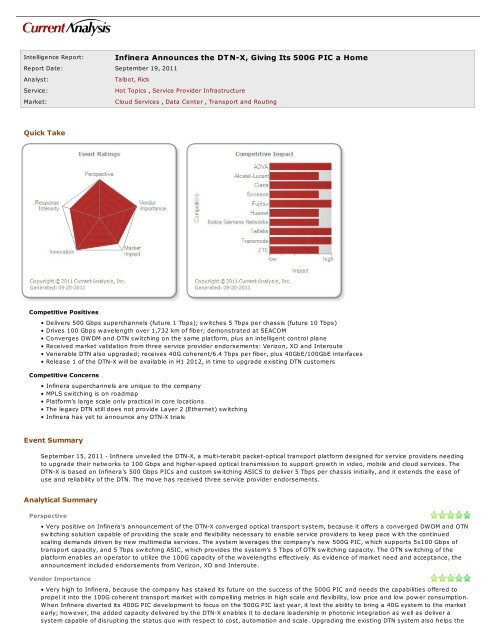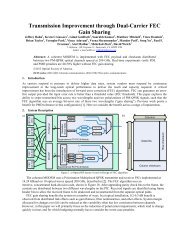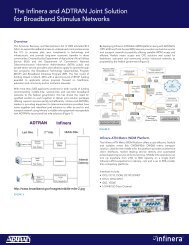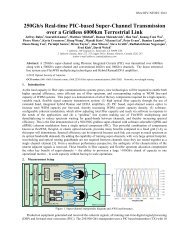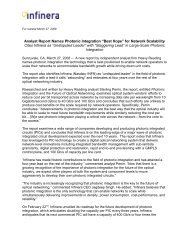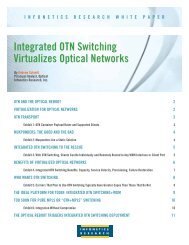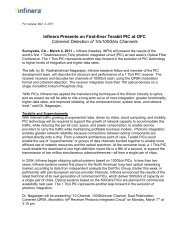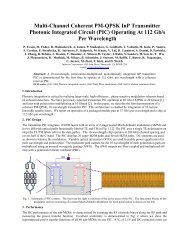Infinera Announces the DTN-X, Giving Its 500G PIC a Home
Infinera Announces the DTN-X, Giving Its 500G PIC a Home
Infinera Announces the DTN-X, Giving Its 500G PIC a Home
You also want an ePaper? Increase the reach of your titles
YUMPU automatically turns print PDFs into web optimized ePapers that Google loves.
Intelligence Report:<strong>Infinera</strong> <strong>Announces</strong> <strong>the</strong> <strong>DTN</strong>-X, <strong>Giving</strong> <strong>Its</strong> <strong>500G</strong> <strong>PIC</strong> a <strong>Home</strong>Report Date: September 19, 2011Analyst:Talbot, RickService:Hot Topics , Service Provider InfrastructureMarket:Cloud Services , Data Center , Transport and RoutingQuick TakeCompetitive Positives• Delivers 500 Gbps superchannels (future 1 Tbps); switches 5 Tbps per chassis (future 10 Tbps)• Drives 100 Gbps wavelength over 1,732 km of fiber; demonstrated at SEACOM• Converges DWDM and OTN switching on <strong>the</strong> same platform, plus an intelligent control plane• Received market validation from three service provider endorsements: Verizon, XO and Interoute• Venerable <strong>DTN</strong> also upgraded; receives 40G coherent/6.4 Tbps per fiber, plus 40GbE/100GbE interfaces• Release 1 of <strong>the</strong> <strong>DTN</strong>-X will be available in H1 2012, in time to upgrade existing <strong>DTN</strong> customersCompetitive Concerns• <strong>Infinera</strong> superchannels are unique to <strong>the</strong> company• MPLS switching is on roadmap• Platform’s large scale only practical in core locations• The legacy <strong>DTN</strong> still does not provide Layer 2 (E<strong>the</strong>rnet) switching• <strong>Infinera</strong> has yet to announce any <strong>DTN</strong>-X trialsEvent SummarySeptember 15, 2011 - <strong>Infinera</strong> unveiled <strong>the</strong> <strong>DTN</strong>-X, a multi-terabit packet-optical transport platform designed for service providers needingto upgrade <strong>the</strong>ir networks to 100 Gbps and higher-speed optical transmission to support growth in video, mobile and cloud services. The<strong>DTN</strong>-X is based on <strong>Infinera</strong>’s 500 Gbps <strong>PIC</strong>s and custom switching ASICS to deliver 5 Tbps per chassis initially, and it extends <strong>the</strong> ease ofuse and reliability of <strong>the</strong> <strong>DTN</strong>. The move has received three service provider endorsements.Analytical SummaryPerspective• Very positive on <strong>Infinera</strong>’s announcement of <strong>the</strong> <strong>DTN</strong>-X converged optical transport system, because it offers a converged DWDM and OTNswitching solution capable of providing <strong>the</strong> scale and flexibility necessary to enable service providers to keep pace with <strong>the</strong> continuedscaling demands driven by new multimedia services. The system leverages <strong>the</strong> company’s new <strong>500G</strong> <strong>PIC</strong>, which supports 5x100 Gbps oftransport capacity, and 5 Tbps switching ASIC, which provides <strong>the</strong> system’s 5 Tbps of OTN switching capacity. The OTN switching of <strong>the</strong>platform enables an operator to utilize <strong>the</strong> 100G capacity of <strong>the</strong> wavelengths effectively. As evidence of market need and acceptance, <strong>the</strong>announcement included endorsements from Verizon, XO and Interoute.Vendor Importance• Very high to <strong>Infinera</strong>, because <strong>the</strong> company has staked its future on <strong>the</strong> success of <strong>the</strong> <strong>500G</strong> <strong>PIC</strong> and needs <strong>the</strong> capabilities offered topropel it into <strong>the</strong> 100G coherent transport market with compelling metrics in high scale and flexibility, low price and low power consumption.When <strong>Infinera</strong> diverted its 400G <strong>PIC</strong> development to focus on <strong>the</strong> <strong>500G</strong> <strong>PIC</strong> last year, it lost <strong>the</strong> ability to bring a 40G system to <strong>the</strong> marketearly; however, <strong>the</strong> added capacity delivered by <strong>the</strong> <strong>DTN</strong>-X enables it to declare leadership in photonic integration as well as deliver asystem capable of disrupting <strong>the</strong> status quo with respect to cost, automation and scale. Upgrading <strong>the</strong> existing <strong>DTN</strong> system also helps <strong>the</strong>
company solidify its customer base with much-needed capacity and service interfaces.Market Impact• High on <strong>the</strong> optical transport and switching markets, because 100G transport is becoming table stakes for all players in all domains (i.e.,both metro and long haul), and <strong>the</strong> new <strong>DTN</strong>-X sets new benchmarks: <strong>500G</strong> super channels, convergence of DWDM and OTN switching, 5Tbps OTN and future MPLS switching capacity, and an intelligent GMPLS-based control plane to automate bandwidth management andsignificantly reduce TCO. <strong>Infinera</strong> is not alone with a converged DWDM and OTN optical transport platform, and several competitors havealso placed MPLS switching on <strong>the</strong>ir roadmaps; however, <strong>Infinera</strong>’s ability to deliver massive scale at much lower cost points will be causefor competitor concern when it demonstrates market traction.Competitive StrengthsCompetitive Positives• <strong>Infinera</strong> delivers a multi-terabit switching/transport platform with massive scale – 500 Gbps superchannel (to be upgraded to 1 Tbps) and5 Tbps OTN switch (to be upgraded to 10 Tbps, plus a multichassis configuration supporting 100 Tbps). This scale, which is significantlygreater than <strong>the</strong> per-chassis transport or OTN switching capacity of competitors’ core optical switching platforms, will enable operators tokeep pace with <strong>the</strong> continued traffic demands driven by emerging multimedia content and new cloud services.• The <strong>DTN</strong>-X is designed to place 100 Gbps on a fiber of up to 1,732 km, as demonstrated at SEACOM (please see <strong>Infinera</strong> Conducts5x100G Trial in Africa, a Crucial Step in <strong>Its</strong> Race to Early 2012 <strong>500G</strong> <strong>PIC</strong> Delivery, August 2, 2011). 100 Gbps transport has become a tablestakes technology to provide transport in <strong>the</strong> network’s core that is seeing massive bandwidth growth and demand for 100G connectionsbetween data centers and between backbone routers. <strong>Infinera</strong> has now demonstrated <strong>the</strong> transmission and receipt of five 100G signals in<strong>the</strong> same <strong>PIC</strong>, a crucial step in delivering its market-disruptive <strong>DTN</strong>-X product in early 2012.• The <strong>DTN</strong>-X supports converged DWDM and OTN switching on <strong>the</strong> same platform and employs an intelligent control plane to minimizeCapEx and OpEx, while providing maximum network control and resilience. The converged DWDM and OTN switching eliminates <strong>the</strong>redundant operating systems and cost of interconnection (CapEx) of separate platforms as well as eliminating <strong>the</strong> need to manageconnections between <strong>the</strong> platforms. The intelligent control plane speeds connection provisioning across <strong>the</strong> network to essentially “pointand-click,”and provides rich recovery capabilities for multiple network failures.• <strong>Infinera</strong> received market validation for <strong>the</strong> <strong>DTN</strong>-X via endorsements from three service providers - Verizon, XO and Interoute. All three of<strong>the</strong>se operators are in ideal position to use <strong>the</strong> <strong>DTN</strong>-X in <strong>the</strong>ir core networks due to <strong>the</strong> physical size of, and broadband connectionscarried by, <strong>the</strong>ir networks. The Verizon endorsement is particularly valuable because <strong>the</strong> vendor had yet to gain traction in ei<strong>the</strong>r of <strong>the</strong>two largest North American operators, AT&T and Verizon.• <strong>Infinera</strong> also announced that it has upgraded its venerable <strong>DTN</strong> with 40G coherent optics and 40GbE/100GbE interfaces, likely extending<strong>the</strong> life of that product. The 40G DWDM optics provides <strong>the</strong> <strong>DTN</strong> a capacity of 6.4 Tbps per fiber, nearly as great as that of 100G DWDMsystems (whose fiber capacities are generally 8.0 Tbps or 8.8 Tbps). The platform’s 40GbE and 100GbE interfaces enable it to supportE<strong>the</strong>rnet connections between routers and switches.• Release 1 of <strong>the</strong> <strong>DTN</strong>-X will be available in H1 2012, in time to upgrade existing <strong>DTN</strong> customers and to participate in <strong>the</strong> acceleration of<strong>the</strong> 100G market. The 100G transport market is in its infancy, with many of <strong>the</strong> announced wins for <strong>the</strong>se systems hardly more than fieldtrials. Most market studies forecast major 100G demand not occurring until 2012-2013. Thus, <strong>Infinera</strong> has <strong>the</strong> chance to introduce aneconomically disruptive product just as <strong>the</strong> mass market takes off. In addition, <strong>the</strong> vendor has maintained <strong>the</strong> H1 2012 delivery target for<strong>the</strong> <strong>DTN</strong>-X throughout <strong>the</strong> product’s development, fostering market confidence in <strong>Infinera</strong>’s ability to deliver.Competitive WeaknessesCompetitive Concerns• <strong>Infinera</strong> superchannels are unique to <strong>the</strong> company, creating a planning scale that is new to operators who are unused to <strong>the</strong> vendor’s<strong>PIC</strong> technology. Specifically, <strong>the</strong> <strong>DTN</strong>-X <strong>500G</strong> DWDM module creates five separate 100G channels, but <strong>the</strong>y are planned and activated as asingle entity; this is unlike all o<strong>the</strong>r 40G and 100G transponders, which are planned and activated one optical channel at a time. Inaddition, many operators will only need to activate one such channel for a significant period of time, so <strong>the</strong> superchannel may be overkill inmany instances.• Though <strong>the</strong> <strong>DTN</strong>-X introduction mentioned a future MPLS capability, <strong>Infinera</strong> provided no details for <strong>the</strong> enhancement of its product withthis capability, or a delivery time frame. If future services become overwhelmingly packet-based, a switching product must ultimatelyprovide packet switching. In addition, Cisco and Juniper appear to be planning for an MPLS transport layer with <strong>the</strong>ir flexible packettransport and converged supercore, respectively. Forward-looking operators are likely to limit <strong>the</strong>ir consideration of core solutions to thosein which <strong>the</strong>y have confidence of layer 2 (MPLS) switching capability.• The large scale of <strong>the</strong> <strong>DTN</strong>-X appears to make it practical in only core locations. Even its half-rack version provides 2 Tbps of OTNswitching, and <strong>the</strong> smallest client connection it supports is 10 Gbps. O<strong>the</strong>r transport (and packet-optical transport) platforms will aggregatea metro’s traffic for connection to <strong>the</strong> <strong>DTN</strong>-X. Thus, regardless of its many features that could be used throughout <strong>the</strong> metro, operators willprobably only use it at metro hub locations.• In this announcement, <strong>Infinera</strong> did not add Layer 2 (E<strong>the</strong>rnet) switching to its portfolio capabilities. The vendor claims that it will equip <strong>the</strong><strong>DTN</strong>-X with MPLS, someday, but o<strong>the</strong>r platforms will need to aggregate all of <strong>the</strong> client connections. Since most packet-based services willuse E<strong>the</strong>rnet connections, and <strong>Infinera</strong> has yet to mention an E<strong>the</strong>rnet switching capability for <strong>the</strong> <strong>DTN</strong>, <strong>the</strong> vendor risks losing business forits <strong>DTN</strong> to competitor packet-optical transport system (P-OTS) products that provide E<strong>the</strong>rnet switching.• <strong>Infinera</strong> stated that it will conduct trials of <strong>the</strong> <strong>DTN</strong>-X in early 2012, but has not identified any operators who will be conducting <strong>the</strong>upcoming trials, nor has it announced any “pre-availability” trials of <strong>the</strong> <strong>DTN</strong>-X. <strong>Infinera</strong> has publicized several preliminary trials of its <strong>500G</strong><strong>PIC</strong> to communicate to <strong>the</strong> market its progress in <strong>the</strong> development of that critical component. Now that <strong>the</strong> vendor has described <strong>the</strong>platform that will employ its <strong>500G</strong> <strong>PIC</strong>, <strong>the</strong> market will require some product trials to build its confidence in <strong>the</strong> <strong>DTN</strong>-X.
Response & Recommendations• <strong>Infinera</strong> needs to articulate a strategy for equipping <strong>the</strong> <strong>DTN</strong>-X with MPLS, ra<strong>the</strong>r than simply state that in subsequent releases <strong>the</strong>product will be upgradeable to MPLS. If future services become overwhelmingly packet-based, <strong>the</strong> <strong>DTN</strong>-X will eventually need to providepacket switching. Forward-looking operators are likely to limit <strong>the</strong>ir consideration of core solutions to those in which <strong>the</strong>y have confidenceof layer 2 (MPLS) switching capability.• For <strong>the</strong> interim period prior to equipping <strong>the</strong> <strong>DTN</strong>-X with MPLS switching, <strong>Infinera</strong> should develop, with a major core router vendor, astrategy for integrating <strong>the</strong> transport functions of <strong>the</strong> <strong>DTN</strong>-X with core routers that it interconnects, and demonstrate that functionality.Operators will want to take advantage of a 100GbE connection between a core router and an adjacent <strong>DTN</strong>-X, but support IP connectionsor label switched paths (LSPs) to multiple far-end routers over that 100GbE physical connection. Competitors Alcatel-Lucent and Huaweihave stated strategies for steering VLANs from <strong>the</strong> router over OTN connections initiated in <strong>the</strong>ir switches.• <strong>Infinera</strong> needs to provide evidence that it is making progress towards delivery by identifying one or more major operators who aretrialing <strong>the</strong> <strong>DTN</strong>-X.• <strong>Infinera</strong> needs to consider providing packet switching capabilities for its <strong>DTN</strong> DWDM platform to provide E<strong>the</strong>rnet switching capability,demand for which is growing among operators. Though <strong>the</strong> product offers OTN switching capability, and <strong>the</strong> <strong>DTN</strong>-X will eventually beequipped with MPLS switching capability, provisioning of E<strong>the</strong>rnet services over a network of <strong>DTN</strong>s and <strong>DTN</strong>-Xs will handicapped because<strong>the</strong> <strong>DTN</strong>s at <strong>the</strong> network’s edge will not recognize VLANs or LSPs. So far, <strong>the</strong> demand for packet switching on <strong>the</strong> <strong>DTN</strong> has been driven byoperator desire to deploy carrier E<strong>the</strong>rnet services. The opportunity to provide 4G backhaul may make packet switching capability “tablestakes.”• Alcatel-Lucent and Ciena need to demonstrate 100G DWDM transport optics on <strong>the</strong>ir core optical switches, <strong>the</strong> 1830 PSS-64 and 5430RSS, respectively, to maintain <strong>the</strong>ir claim on core transport technical leadership. Both vendors were among <strong>the</strong> first to deliver 100G DWDMtransport and both offer core optical switching, but nei<strong>the</strong>r has demonstrated switching integrated with <strong>the</strong> 100G transport. In addition,both will need to consider bolstering <strong>the</strong> 100G DWDM port density of <strong>the</strong>ir platforms as <strong>the</strong> <strong>DTN</strong>-X will lead <strong>the</strong> pack in 100G DWDM portdensity.• Cisco should conduct and announce a trial of its 100G transport system to indicate that it is also a player in <strong>the</strong> 100G DWDM transportmarket. It also needs to develop a strategy to offset its lack of a core optical switch. Most of <strong>the</strong> o<strong>the</strong>r major DWDM vendors haveannounced 100G trials, and <strong>Infinera</strong> appears to be on <strong>the</strong> doorstep of introducing an economically disruptive product. Cisco has announcedits acquisition of CoreOptics, giving it <strong>the</strong> technology necessary to develop such transport capability, but has been silent since. The vendorrisks tier 1 operator business without core optical (OTN) switching.• Now that it has released its 100G transport product, NSN should document 100G transport in its hiT 7300 (and, even better, <strong>the</strong> hiT7100) with a customer trial to validate this capability. Several vendors have already completed 100G trials, Alcatel-Lucent and Ciena havecommercially available products, and now <strong>Infinera</strong> threatens to impact <strong>the</strong> market’s margins negatively by introducing <strong>the</strong> economicallydisruptive <strong>DTN</strong>-X. NSN needs to gain mind share in prospects who are in <strong>the</strong> planning process with public 100G customer announcementsprior to being squeezed out by market predecessors on one hand and <strong>Infinera</strong> on <strong>the</strong> o<strong>the</strong>r.• Vendors such as Ericsson, Huawei, Tellabs and ZTE should announce availability dates for <strong>the</strong>ir 100G products as soon as possible. Thesevendors have completed 100G trials, but are not publicly projecting availability dates for <strong>the</strong>ir products. Not only have numerouscompetitors committed to 100G transport delivery dates, but <strong>Infinera</strong> promises to raise <strong>the</strong> bar (or is that lower <strong>the</strong> cost bar?) with its H12012 delivery of <strong>the</strong> <strong>DTN</strong>-X. Vendors cannot afford to be considered slow in <strong>the</strong>ir delivery of 100G transport by not committing to availabilitydates; <strong>the</strong>y need to engage <strong>the</strong>ir customers in <strong>the</strong> planning process with firm 100G product roadmaps.Buyer Actions• Tier 1 carriers should seek to bring <strong>Infinera</strong>’s <strong>DTN</strong>-X into <strong>the</strong>ir labs for thorough testing. The new product promises to provide unparalleledtransport and switching capacity – capacity that <strong>the</strong>se carriers have demanded to address a tsunami of core traffic driven by multiplyingend users of HD video content and, soon, cloud services. The ability to switch and transport massive amounts of this traffic economicallyand effectively will be a strategic, and competitive, requirement of operators in a rapidly approaching future.• Operators should press <strong>Infinera</strong> for its strategy for providing efficient packet transport. The vendor claims it has planned for an MPLScapability for <strong>the</strong> <strong>DTN</strong>-X, but does not specify a road to that capability, and has not issued any plans for equipping <strong>the</strong> <strong>DTN</strong> with packetswitching. Because <strong>the</strong> <strong>DTN</strong>-X supports interfaces at 10 Gbps and higher, packet-based services such as E<strong>the</strong>rnet will need to beaggregated by packet-aware equipment prior to being connected to <strong>the</strong> <strong>DTN</strong>-X even after it is upgraded to support MPLS. Any operatorswho wish to provide carrier E<strong>the</strong>rnet will need to learn <strong>Infinera</strong>’s plans to support that service.• Modestly sized operators should inquire of <strong>Infinera</strong> how to cost justify provisioning at an increment of 500 Gbps per route. The vendordoes offer <strong>the</strong> half-rack version (2 Tbps OTN switching capacity) of its <strong>DTN</strong>-X, which may provide appropriate switching scale for thoseoperators. However, it is doubtful that an operator who currently supports, for example, ten 10G wavelengths per fiber route will need <strong>the</strong>50 x 10G wavelength capacity of <strong>the</strong> <strong>DTN</strong>-X anytime soon.All materials Copyright 1997-2011 Current Analysis, Inc. Reproduction prohibited without express written consent. Current Analysis logos are trademarks of CurrentAnalysis, Inc. The information and opinions contained herein have been based on information obtained from sources believed to be reliable, but such accuracy cannot beguaranteed. All views and analysis expressed are <strong>the</strong> opinions of Current Analysis and all opinions expressed are subject to change without notice. Current Analysis doesnot make any financial or legal recommendations associated with any of its services, information, or analysis and reserves <strong>the</strong> right to change its opinions, analysis, andrecommendations at any time based on new information or revised analysis.Current Analysis, Inc.21335 Signal Hill Plaza, Second Floor, Sterling, VA 20164
Current Analysis, Inc.21335 Signal Hill Plaza, Second Floor, Sterling, VA 20164Tel: 877-787-8947Fax: +1 (703) 404-9300Current Analysis, Inc.2 rue Troyon, 92316 Sevres Cedex, Paris, FranceTel: +33 (1) 41 14 83 17http://www.currentanalysis.com


